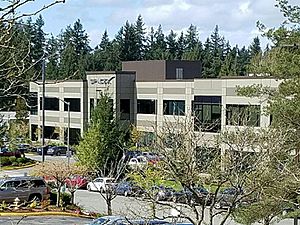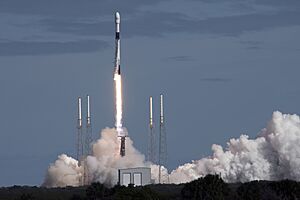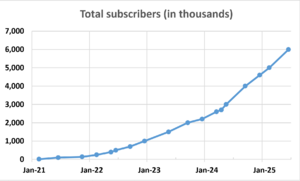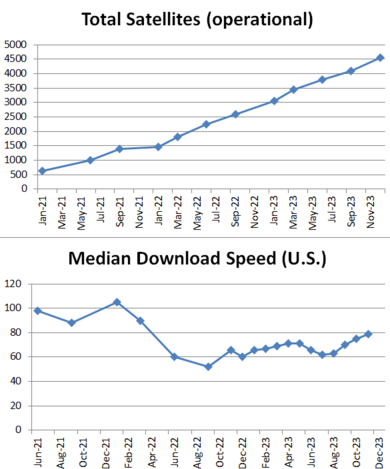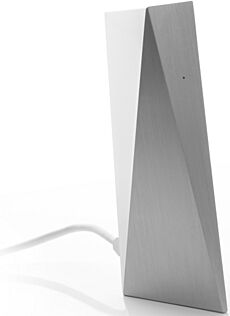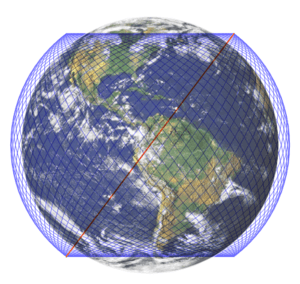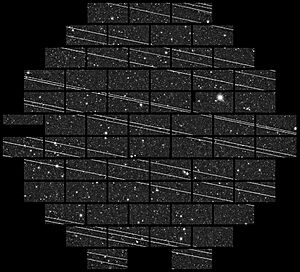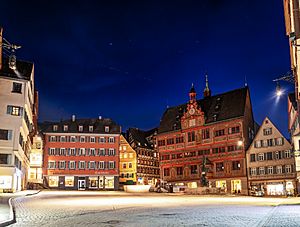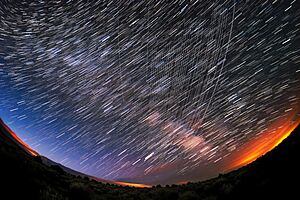Starlink facts for kids
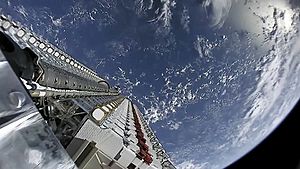
60 Starlink satellites stacked together before deployment on May 24, 2019
|
|
| Manufacturer | SpaceX |
|---|---|
| Country of origin | United States |
| Operator | Starlink Services, LLC (a wholly-owned subsidiary of SpaceX) |
| Applications | Internet service |
| Specifications | |
| Spacecraft type | Small satellite |
| Launch mass |
|
| Equipment |
|
| Regime |
|
| Production | |
| Status |
|
 |
|
Starlink is a huge group of satellites that provide internet service from space. It's run by Starlink Services, LLC, which is part of the American space company SpaceX. Starlink offers internet to about 130 countries and aims to provide mobile internet everywhere. It has helped SpaceX grow a lot.
SpaceX started sending Starlink satellites into space in 2019. As of August 2025, there are over 7,600 of these small satellites orbiting Earth. They are in a low Earth orbit (LEO) and talk to special dishes on the ground. Starlink satellites make up 65% of all active satellites in space! SpaceX plans to launch nearly 12,000 satellites, and maybe even 34,400 later. In December 2022, Starlink had over 1 million users, and by September 2024, it had 4 million.
The main place for Starlink's research, building, and control is in Redmond, Washington. In 2018, SpaceX thought it would cost at least $10 billion to create and launch the whole system. Starlink made $1.4 billion in 2022. By May 2024, its yearly income was expected to reach $6.6 billion, and by December, it was raised to $7.7 billion. In 2025, it was expected to reach $11.8 billion. Starlink made a profit of $72 million in 2024, which was its first profitable year.
Starlink has been used a lot in the Russo-Ukrainian War. The United States Department of Defense even has a contract for it. There's also a special military version called Starshield for government use.
Some astronomers worry that these many satellites will make it harder to see stars and affect radio telescopes. SpaceX has tried to make the satellites less bright. The satellites have special engines that help them move, stay in orbit, and fall back to Earth safely when they are old. They can also avoid crashing into other objects in space by themselves.
Contents
How Starlink Started
Early Ideas for Satellites
Ideas for groups of satellites in low Earth orbit began in the 1980s. In the 1990s, some companies tried to build large satellite internet systems like Iridium and Globalstar. But these companies went bankrupt because it was too expensive to launch satellites back then.

In 2004, Larry Williams, a SpaceX executive, opened a SpaceX office in Washington D.C. SpaceX also bought a part of a company called Surrey Satellite Technology (SSTL), which was working on extending the internet into space. However, SpaceX later sold its share in SSTL.
In 2014, Elon Musk and Greg Wyler planned a group of about 700 satellites. This would have been much bigger than any satellite group at the time. But their talks ended, and SpaceX started its own project. SpaceX named its satellite internet network Starlink, inspired by the 2012 book The Fault in Our Stars.
Designing the Satellites
Starlink was first announced in January 2015 when SpaceX opened its satellite development center in Redmond, Washington. Elon Musk said there was a big need for affordable internet around the world. He also said that money from Starlink would help fund SpaceX's plans to go to Mars. SpaceX even has long-term plans to build a Starlink system for Mars.
The company started with 60 engineers in a rented space. By 2018, SpaceX moved all its Seattle operations to a bigger facility to build satellites and do research. They also opened an office in Irvine, California, to work on the satellite's electronic parts.
By October 2016, the main challenge was making the user equipment (the dishes people would use) cheap enough.
Building and Testing
In November 2016, SpaceX asked the FCC (a US government agency that controls communications) for permission to use certain radio frequencies for its satellites. In September 2017, the FCC gave them a license. It said that half of the satellites needed to be in orbit within six years, and the whole system within nine years.
SpaceX also told the FCC how they would deal with space debris. They said satellites would safely fall out of orbit within about a year after their mission ends.
In March 2018, the FCC approved the first 4,425 satellites. They also asked SpaceX to make sure 90% of the satellites would de-orbit reliably.
In May 2018, SpaceX estimated the total cost to build the system would be around $10 billion.
First Launches and Beta Testing
After launching two test satellites in February 2018, the first 60 working Starlink satellites were launched in May 2019.
By late 2019, SpaceX was building satellites very quickly. They needed to launch about 44 satellites every month for five years to meet their goals. SpaceX said they would meet the deadlines for having their satellites in orbit.
In July 2020, Starlink started a limited test internet service for some people. They paid a small fee to test the billing. In October 2020, a wider public test began. Testers paid the full monthly cost and could talk about their experience. They reported speeds over 150 Mbit/s, which was faster than expected.
Starlink for Everyone
People in the United States and Canada could start pre-ordering Starlink in early 2021.
The FCC had offered SpaceX $885.5 million to help provide internet to rural areas in 35 US states. But in August 2022, the FCC took back the money. They said Starlink "failed to show" it could provide the promised service. SpaceX disagreed, saying they met all the rules. In December 2023, the FCC officially denied SpaceX's appeal.
In March 2021, SpaceX asked the FCC for permission to use Starlink dishes on vehicles, boats, and airplanes. This was approved for moving vehicles.
In 2022, SpaceX launched Starlink Business, a faster service with a bigger antenna. It cost $2500 for the antenna and $500 per month. It offered speeds of 150 to 500 Mbit/s.
On December 1, 2022, the FCC approved SpaceX to launch the first 7,500 satellites for its second-generation (Gen2) system. These satellites would orbit at different low altitudes.
In March 2023, SpaceX was making six Starlink "v2 mini" satellites every day, plus thousands of user dishes. The v2 mini satellites are smaller versions of the Gen2 satellites that can be launched by the Falcon 9 rocket. The larger Gen2 satellites need the huge Starship rocket to launch them.
Starlink made a profit for the first time in 2024.
In 2024, there were some disagreements between Brazil and Elon Musk's companies. Brazil's telecom agency threatened to stop Starlink because of a ban on X (formerly Twitter).
In October 2024, The Wall Street Journal reported that Elon Musk had been talking with Russian officials. They said Putin asked Musk not to turn on Starlink over Taiwan. Musk had supported Ukraine with Starlink but later limited its use. In November 2024, Musk told Ukrainian President Volodymyr Zelenskyy he would keep supporting Ukraine with Starlink.
SpaceX asked its suppliers in Taiwan to move production elsewhere because of worries about global politics. This made many Taiwanese people upset.
In November 2024, SpaceX suggested a Starlink system for Mars, called "Marslink." It would provide over 4 Mbit/s of internet between Earth and Mars.
Since July 2024, SpaceX has been testing Starlink with Romania's Ministry of National Defense. These tests aim to improve Starlink's speed and coverage without affecting older satellites. The results will help change old rules about non-geostationary satellites.
In March 2025, a US government official resigned, saying there was too much focus on Starlink from the US government. Some Starlink users in the UK also protested Elon Musk's political actions. The US government installed a Starlink dish at the White House, which raised some questions. The White House said it was donated and approved. After the US government started new tariffs, the State Department encouraged countries to approve American satellite companies like Starlink. Countries like India approved Starlink, hoping it would help avoid tariffs.
Starlink Users
As of February 2025, Starlink has more than 5 million customers around the world.
| Month | Users |
|---|---|
| February 2021 | ≈ 10,000 |
| June 2021 | ≈ 100,000 |
| November 2021 | ≈ 140,000 |
| February 2022 | ≈ 250,000 |
| May 2022 | ≈ 400,000 |
| June 2022 | ≈ 500,000 |
| September 2022 | ≈ 700,000 |
| December 2022 | ≈ 1,000,000 |
| May 2023 | ≈ 1,500,000 |
| September 2023 | ≈ 2,000,000 |
| December 2023 | ≈ 2,200,000 |
| March 2024 | ≈ 2,600,000 |
| April 2024 | ≈ 2,700,000 |
| May 2024 | ≈ 3,000,000 |
| September 2024 | ≈ 4,000,000 |
| December 2024 | ≈ 4,600,000 |
| February 2025 | ≈ 5,000,000 |
| June 2025 | ≈ 6,000,000 |
Starlink Services
Internet from Space
Starlink provides internet from satellites to places on Earth that don't have good internet. It also offers competitive service in cities.
When it first launched in the US, Starlink cost $599 for the dish and $120 per month for internet at one location. For an extra $25 per month, you could move your dish (Starlink For RVs). However, speeds might be slower than for fixed users. Regular users could expect speeds of 50 to 150 Mbit/s. A study found average download speeds were 90.55 Mbit/s in early 2022, but dropped to 62.5 Mbit/s later.
A faster service called Starlink Business offers speeds of 150 to 500 Mbit/s. It costs $2,500 for the dish and $500 per month. Starlink Maritime launched in July 2022 for internet on the ocean. It offers 350 Mbit/s, but the dish costs $10,000 and the monthly fee is $5,000.
Starlink limits the number of users in each area because of limited capacity. They offer a Best Effort service for people on a waiting list. This service uses any unused internet capacity in their area. To improve service in busy areas, Starlink added a 1 TB data limit per month for non-business users starting in 2023.
In August 2022, SpaceX lowered monthly prices for users in some countries, like Brazil and Chile, by about 50%.
According to Ookla, an internet analysis company, Starlink speeds slowed down in early 2022 as more customers joined. SpaceX says speeds will get better as more satellites are launched.
In September 2023, SES announced a new internet service for cruise ships. It uses both Starlink satellites and SES's own satellites to provide fast internet (up to 3 Gbit/s) to ships worldwide. Virgin Voyages was the first cruise line to use this service in February 2024.
Satellite Phone Service
T-Mobile US and SpaceX are working together to add satellite phone service to Starlink satellites. This will provide cell phone coverage in areas without regular cell service across the US. It will start with text messages and later include voice calls and limited data. Testing began in 2024. T-Mobile phones will connect directly to Starlink satellites without needing special equipment. The first six satellites with this phone capability launched on January 2, 2024.
Rogers Communications in Canada and One NZ (formerly Vodafone New Zealand) also signed agreements with SpaceX for satellite-to-phone services. Optus in Australia announced a similar partnership. On January 8, 2024, SpaceX confirmed they successfully tested text messaging using this new feature on T-Mobile's network.
Starshield for Governments
In December 2022, SpaceX announced Starshield, a separate Starlink service for governments and military groups. Starshield allows the US Department of Defense (DoD) to own or rent Starshield satellites for its partners. Starshield is designed for military use, with features like encryption and anti-jamming. Elon Musk said Starlink should be a civilian network, but Starshield will be owned and controlled by the US government.
Starshield satellites can carry different types of equipment. They can also connect to the regular Starlink satellites using lasers.
In January 2022, SpaceX launched four national security satellites for the US government. In September 2023, the Starshield program received its first contract from the United States Space Force. This contract is for customized satellite communications for the military.
Starlink's Uses
Military Uses
SpaceX also builds and launches special military satellites based on Starlink designs. The biggest known customer is the Space Development Agency (SDA). The SDA works to quickly develop ways to defend against missiles, mainly using low-cost satellites in low Earth orbit.
In October 2020, the SDA gave SpaceX a $150 million contract to build four satellites to find and track missiles. These satellites launched in April 2023.
In 2019, the US Air Force tested Starlink and achieved a very fast data link to an aircraft. They also successfully tested a connection with Starlink on an AC-130 Gunship. In 2020, the Air Force used Starlink during a live-fire exercise, connecting it to various air and ground vehicles.
Experts say that Starlink signals are harder for enemies to block during wartime because they use narrow, focused beams.
In May 2022, Chinese military researchers wrote an article about how to destroy the Starlink system if it threatened their country. Russian officials have also warned Elon Musk that Starlink could become a military target.
In the Russo-Ukrainian War
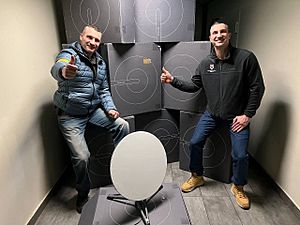
Starlink was turned on during the Russian invasion of Ukraine after Ukraine asked for help. Ukraine's military and government quickly started relying on Starlink for internet access. Starlink helps Ukraine communicate with the outside world and keep its energy systems working.
The service is also used in warfare. Starlink helps connect drones, naval drones, and systems for directing artillery fire. SpaceX has expressed concerns about using Starlink for attacks beyond military communications. Its use in attacking Russian targets has been criticized by Russia.
Elon Musk said the service was costing $20 million per month. In June 2023, the United States Department of Defense signed a contract with SpaceX to pay for Starlink's use in Ukraine.
In February 2025, US negotiators reportedly pressured Ukraine to allow access to its minerals by threatening to shut down Starlink. This happened after Ukraine's president rejected a US proposal for mineral rights in exchange for aid. Elon Musk denied these claims.
In the Gaza War
In October 2023, after the Gaza war began, people asked Elon Musk to activate Starlink in Gaza because internet service was lost there. Musk said Starlink would be provided for aid groups in Gaza. In November, Musk said Starlink would only be provided with Israel's approval.
In the Mali War and War in the Sahel
Groups like Jama'at Nasr al-Islam wal-Muslimin and Islamic State – West Africa Province have been using Starlink devices illegally in the Mali War. These devices help them communicate more securely, making it harder for government forces to stop their plans.
In response, the governments of Niger and Chad have tried to make Starlink legal. They hope this will help them control the technology by requiring devices to be registered.
Starlink has also been used by the Azawadi separatist group, FLA, and the armed forces of Mali. The FLA used Starlink to coordinate operations and share information.
Criminal Uses
The Associated Press reported in 2023 that criminal groups in Brazil were using Starlink in remote parts of the Amazon rainforest.
According to Wired magazine, Starlink helps scam centers in Southeast Asia. Criminals running large operations use the satellite internet network. Wired found over a hundred Starlink devices at one center in Myanmar.
Starlink's global internet service is a concern for countries because it works without local infrastructure or government approval. In India, during the Manipur conflict, militant groups reportedly used smuggled Starlink devices to get around internet shutdowns. In Iran, Elon Musk announced Starlink was activated in 2022 after the Iranian government blocked the internet. This helped citizens get uncensored access. These cases show how hard it is for governments to control unauthorized satellite communications.
Where Starlink is Available
To offer satellite services in any country, Starlink needs permission from that country's government and communication regulators. Even though the Starlink network covers almost the whole world below 60° latitude, it can only provide internet in 115 countries as of July 2025. SpaceX also considers business reasons when deciding where and when to offer service. For example, Canada approved Starlink in November 2020, and service started two months later. As of September 2022, Starlink was available in 40 countries, with many more waiting for approval.
Canada was the first country outside the US to approve Starlink in November 2020.
In May 2022, Starlink started service in the Philippines, its first country in Asia. This was possible because of a new law that allowed foreign companies to own utility businesses like internet providers.
In August 2022, SpaceX got its first contract for passenger ships. Royal Caribbean Group started adding Starlink internet to its cruise ships. JSX airline planned to offer Starlink on private jet charter flights in the US in late 2022. Hawaiian Airlines also agreed to provide Starlink on its flights to and from Hawaii in 2023.
In June 2023, Starlink got a license to offer internet in Zambia. It officially went live there in October 2023. In July 2023, the Mongolian government also gave SpaceX two licenses for internet access.
In July 2023, Bloomberg reported that attempts to sell Starlink in Taiwan in 2022 failed. SpaceX wanted 100% ownership of its Taiwan company, but Taiwanese law requires local companies to control at least 51% of internet providers.
Japan's main mobile provider, KDDI, partnered with SpaceX to offer better internet to rural mobile customers using Starlink.
On April 25, 2022, Hawaiian Airlines announced it would offer free Starlink internet on its planes, becoming the first airline to do so. By July 2022, Starlink was available in 36 countries.
In May 2022, Nigeria, Mozambique, and the Philippines approved Starlink. Commercial service began in the Philippines on February 22, 2023.
In September 2022, tests began at McMurdo Station in Antarctica. Starlink uses satellites that orbit over the poles to connect to ground stations in other countries.
In September 2023, a US group started donating Starlink subscriptions and dishes to Iranians to help them get around internet blackouts.
In September 2023, some Indian news outlets reported that Starlink would soon get its license to operate in India. SpaceX had already sold 5,000 pre-orders in India. However, the Indian government told SpaceX to stop selling pre-orders until it got approval. In April 2024, it was reported that Starlink had received "in-principle government approval" in India.
In November 2023, Starlink received licenses to operate in Fiji. The service launched there in May 2024. In April 2024, it was reported that the company would start trial service in Indonesia in May. Starlink received its license in Indonesia in early May.
In May 2024, Starlink service became available for pre-order in Sri Lanka. In August 2024, Starlink Lanka (Private) Limited got a license to operate. However, in March 2025, the government paused the rollout due to security concerns. By June 2, 2025, all conditions were met, and Starlink officially launched in Sri Lanka on July 2, 2025.
In August 2024, Starlink received licenses to operate in Yemen. In April 2025, Houthi rebels in Yemen demanded that people give up their Starlink devices.
In September 2024, United Airlines announced it would install Starlink on all its planes to offer free high-speed Wi-Fi to passengers. In March 2025, the FAA approved United to start putting Starlink antennas on its aircraft.
On October 22, 2024, Qatar Airways launched the first Starlink-equipped Boeing 777 flight. As of November 2024, Morocco is expected to approve Starlink by 2025.
On March 11 and 12, 2025, Indian telecom companies Airtel and Jio partnered with Starlink to bring satellite internet to India. This aims to improve internet in remote areas.
Although Starlink was not officially available in South Africa, it was found in June 2025 that it had been operating there illegally since 2022. South Africans used Starlink's roaming service. In June 2025, Starlink started telling its users in South Africa that their service was suspended. In March 2025, Elon Musk claimed Starlink couldn't get a license in South Africa because he wasn't black. This claim has been disputed by South African officials.
Iran
In 2022, the US government allowed Starlink to be sent to Iran to help people during protests when the Iranian government blocked the internet. Starlink service was activated in Iran right away. In 2023, the Iranian government complained to the ITU (an international communication group) about Starlink operating without permission. The ITU sided with Iran. Despite being illegal, the number of Starlink users in Iran has grown a lot through black market sales. Iranian officials say there are 30,000 Starlink dishes in the country, giving access to about 100,000 users.
Countries with Starlink Availability
| # | Continent | Country/Territory | Debut | Notes |
|---|---|---|---|---|
| 1 | North America, Oceania | Limited trials August 2020, public beta November 2020 | Service expanded to Guam and Northern Mariana Islands in November 2023. | |
| 2 | North America | January 2021 | ||
| 3 | Europe, Oceania | January 2021 | Free trial in Pitcairn Islands started in November 2022. | |
| 4 | Europe | March 2021 | ||
| 5 | Oceania | April 2021 | Service expanded to Cook Islands in September 2024. | |
| 6 | Oceania | April 2021 | ||
| 7 | Europe, North America, South America, Africa | Original debut May 2021, Revoked April 2022, Re-approved June 2022 | Approval originally given in February 2021 but the Conseil d'État annulled that Decision on April 5, 2022, due to lack of public consultation. Approval was given again after consultation was completed on June 2, 2022. Service expanded to Saint Martin and Saint Barthélemy in July 2022. Service expanded to Martinique and Guadeloupe in September 2022. Expanded to Guyane in April 2023. | |
| 8 | Europe | May 2021 | ||
| 9 | Europe | May 2021 | Service expanded to Sint Maarten in May 2025. | |
| 10 | Europe | May 2021 | ||
| 11 | Europe | Limited trials April 2021, public beta July 2021 | ||
| 12 | Europe | July 2021 | Service expanded to Faroe Islands in May 2025. Autonomous territory Greenland not covered. | |
| 13 | Europe | August 2021 | ||
| 14 | Europe | August 2021 | ||
| 15 | Europe | August 2021 | ||
| 16 | South America | Limited trials July 2021, public beta September 2021 | Service expanded to Easter Island in November 2022. | |
| 16 | Europe | September 2021 | ||
| 17 | Europe | September 2021 | ||
| 18 | Europe | September 2021 | ||
| 19 | Europe | October 2021 | ||
| 20 | North America | November 2021 | ||
| 21 | Europe | November 2021 | ||
| 22 | Europe | December 2021 | ||
| 23 | Europe | January 2022 | ||
| 24 | Europe | January 2022 | ||
| 25 | Europe | January 2022 | ||
| 27 | South America | January 2022 | ||
| 28 | Europe | February 2022 | ||
| 29 | Europe | February 2022 | Initially supplied as emergency relief in response to the 2022 Russian invasion of Ukraine. See Starlink satellite services in Ukraine. | |
| 30 | Europe | April 2022 | ||
| 31 | Europe | April 2022 | ||
| 32 | Europe | April 2022 | ||
| 33 | Europe | May 2022 | ||
| 34 | Europe | June 2022 | ||
| 35 | Europe | June 2022 | ||
| 35 | Europe | July 2022 | ||
| 36 | North America | July 2022 | ||
| 37 | Europe | August 2022 | ||
| 38 | Europe | August 2022 | ||
| 39 | Europe | August 2022 | Svalbard and Jan Mayen added in February 2025. | |
| 40 | Europe | September 2022 | ||
| 41 | Asia | September 2022 | Activated without Iranian government permission, but with permission of the U.S. government, in response to internet blackout in Iran as a result of the Mahsa Amini protests. Estimated 20 thousand terminals as of 2024. | |
| 42 | Asia | October 2022 | First in Asia. | |
| 43 | North America | October 2022 | ||
| 44 | Europe | November 2022 | Autonomous region Åland added in February 2025. | |
| 45 | North America | November 2022 | ||
| 46 | South America | January 2023 | ||
| 47 | Africa | January 2023 | First in Africa. | |
| 48 | South America | January 2023 | ||
| 49 | Europe | February 2023 | ||
| 50 | Africa | February 2023 | ||
| 51 | Asia | February 2023 | ||
| 52 | North America | March 2023 | ||
| 53 | South America | March 2023 | ||
| 54 | North America | April 2023 | ||
| 55 | North America | May 2023 | ||
| 56 | Africa | June 2023 | ||
| 57 | North America | June 2023 | ||
| 58 | Europe | July 2023 | ||
| 59 | North America | July 2023 | ||
| 60 | Africa | July 2023 | ||
| 61 | Asia | July 2023 | ||
| 62 | Africa | July 2023 | ||
| 63 | North America | August 2023 | ||
| 64 | Africa | October 2023 | ||
| 65 | Europe/Asia | November 2023 | ||
| 66 | Africa | November 2023 | ||
| 67 | Asia | November 2023 | ||
| 68 | North America | November 2023 | ||
| 69 | North America | December 2023 | ||
| 70 | Africa | December 2023 | ||
| 71 | South America | December 2023 | ||
| 72 | Asia | March 2024 | ||
| 73 | South America | March 2024 | ||
| 74 | Europe | April 2024 | ||
| 75 | Oceania | April 2024 | ||
| 76 | South America | May 2024 | ||
| 77 | Asia | May 2024 | ||
| 78 | Oceania | May 2024 | ||
| 79 | Africa | June 2024 | ||
| 80 | Africa | June 2024 | ||
| 81 | Oceania | August 2024 | ||
| 82 | Africa | August 2024 | ||
| 83 | Africa | August 2024 | ||
| 84 | Africa | August 2024 | ||
| 85 | Oceania | September 2024 | ||
| 86 | Africa | September 2024 | ||
| 87 | Asia | September 2024 | ||
| 88 | Africa | September 2024 | ||
| 89 | Oceania | October 2024 | ||
| 90 | Oceania | October 2024 | ||
| 91 | Asia | October 2024 | Originally available for business customers only. Residential service available since July 2025 | |
| 92 | Africa | December 2024 | ||
| 93 | Asia | December 2024 | ||
| 94 | Oceania | December 2024 | ||
| 95 | Europe | December 2024 | ||
| 96 | Africa | January 2025 | ||
| 97 | Oceania | January 2025 | ||
| 98 | Asia | February 2025 | ||
| 99 | Africa | March 2025 | ||
| 100 | Oceania | March 2025 | ||
| 101 | Europe/Asia | March 2025 | ||
| 102 | Asia | March 2025 | ||
| 103 | Europe/Asia | March 2025 | ||
| 104 | South America | April 2025 | ||
| 105 | Asia | April 2025 | ||
| 106 | North America | April 2025 | ||
| 107 | Asia | May 2025 | ||
| 108 | Asia | May 2025 | ||
| 109 | Africa | June 2025 | ||
| 110 | North America | June 2025 | ||
| 111 | Oceania | June 2025 | ||
| 112 | Africa | June 2025 | ||
| 113 | Africa | June 2025 | ||
| 114 | Asia | July 2025 | ||
| 115 | Africa | July 2025 |
Starlink Technology
Satellite Design
The first Starlink satellites launched in May 2019 weighed 227 kg each. SpaceX decided to put them in a lower orbit (550 km) to reduce space debris and use fewer satellites. Early plans in 2015 were for about 4,000 satellites.
The satellites use lasers to talk to each other in space. They also use special antennas and digital technology to send and receive internet signals. SpaceX keeps the details of the laser links secret. The laser links were successfully tested in late 2020.
Starlink satellites are made in large numbers, which makes them much cheaper than older satellites. Elon Musk wants to make satellites as revolutionary as rockets. He believes smaller satellites are key to making space internet cheaper.
In February 2015, SpaceX asked the FCC to consider new uses for certain radio frequencies before making rules for 5G internet. This was because SpaceX was new to the satellite communication market.
Internet from older satellites in high orbits can be slow, taking 600 milliseconds or more for a signal to go back and forth. Starlink satellites are much closer to Earth, so they offer faster speeds, around 25 to 35 milliseconds. This is similar to regular cable internet. The system also uses a special internet language that is simpler than IPv6 and has built-in encryption.
Starlink satellites use special engines called Hall-effect thrusters. These engines use krypton or argon gas to move the satellites, keep them in orbit, and bring them back to Earth at the end of their lives. SpaceX says its newer engines using argon are more powerful.
User Dishes
The Starlink system connects directly to cell phones and also provides broadband internet. The direct-to-cell feature works with regular cell phones and is being offered globally with phone companies. Starlink's internet service uses flat dishes, about the size of a pizza box. These dishes have special antennas that track the satellites. You can mount them anywhere as long as they can see the sky, even on fast-moving trains. Elon Musk once said the dishes look like a "UFO on a stick." The dish can move itself to find the best angle to see the sky. It's known as "Dishy McFlatface" inside the company.
In October 2020, SpaceX launched a paid test service called "Better Than Nothing Beta." It cost $499 for the dish and promised speeds of 50 to 150 Mbit/s. In January 2021, this service expanded to other countries, starting with the United Kingdom.
A larger, more powerful dish is available for the Starlink Business service.
In September 2020, SpaceX asked for permission to put dishes on 10 of its ships, planning to enter the maritime market.
In August 2022, a security expert named Lennert Wouters looked at the Starlink dishes. He found that the main control unit uses a special chip called Catson, which runs a Linux system. The dish also has a GPS receiver and motors.
In June 2024, a small, portable dish called "Starlink Mini" was announced. It fits in a backpack and offers 100 Mbit/s download speed. It first launched in Latin America for $200.
Ground Stations
SpaceX has asked the FCC for permission to build at least 32 ground stations in the United States. As of July 2020, they had approval for five of them. Until February 2023, Starlink used a certain radio band to connect with ground stations. With the launch of newer satellites, they added more frequencies.
A typical ground station has nine large antennas in a fenced area. SpaceX plans to install its ground stations at Google data centers around the world.
Satellite Updates
SpaceX has made several versions of its Starlink satellites.
Tintin
The first two test satellites, called Tintin A and Tintin B, launched on February 22, 2018. They were meant to go higher but stayed in a lower orbit. SpaceX later decided to operate many of its satellites at this lower altitude.
v0.9 (Test)
The 60 Starlink v0.9 satellites launched in May 2019.
- They had a flat design with multiple antennas and one solar panel.
- Each weighed 227 kg.
- They used Hall-effect thrusters with krypton gas to adjust their position and deorbit.
- They had a star tracker system for precise aiming.
- They could avoid collisions using data from the US Department of Defense.
- They orbited at 550 km.
- 95% of their parts would burn up in Earth's atmosphere when they deorbited.
v1.0 (Operational)
Starlink v1.0 satellites launched starting November 2019.
- 100% of their parts would burn up completely in Earth's atmosphere at the end of their life.
- They added a new radio band (Ka-band).
- Each weighed 260 kg.
- One satellite, called DarkSat, had a special coating to make it less bright, but this didn't work well.
- All satellites launched since August 2020 have visors to block sunlight and reduce brightness.
v1.5 (Operational)
Starlink v1.5 satellites launched starting January 24, 2021.
- They had lasers for communication between satellites.
- Each weighed about 295 kg.
- The visors were removed from satellites launched from September 2021 onwards.
Starshield (Operational)
These are special satellite bodies for military use, based on Starlink v1.5 and v2.0. They can carry secret government or military equipment.
v2 (Newer Satellites)
SpaceX started preparing for Starlink v2 satellites in early 2021. Elon Musk said they would be much better than Starlink 1 in terms of internet speed.
SpaceX hoped to launch Starlink v2 in 2022. As of May 2022, SpaceX said the second-generation (Gen2) satellites would need to be launched by Starship because they are too big for the Falcon 9 rocket. However, in August 2022, SpaceX said they would build Gen2 satellites in two sizes: one for Falcon 9 and one for Starship. Starlink v2 satellites are larger and heavier than v1.
Gen2 Starlink satellites planned for Starship:
- Lasers for communication between satellites.
- Weigh about 1250 kg.
- Are about 7 meters long.
- Have new ways to reduce their brightness, like a mirror-like film.
- 2,016 of the first 7,500 satellites will have a special antenna (about 25 square meters) that lets T-Mobile cell phones connect directly to them.
In October 2022, SpaceX showed the design for early v2s that would launch on Falcon 9. In May 2023, SpaceX introduced two more designs with direct-to-cellular (DtC) capability.
- Bus F9-1: Weighs 303 kg, similar size to V1.5 satellites.
- Bus F9-2 (called "v2 mini"): Weighs up to 800 kg and is 4.1 m by 2.7 m. It has two solar arrays and can offer 3-4 times more internet capacity per satellite. It uses more efficient antennas and new radio frequencies.
- Bus F9-3: This is an F9-2 with direct-to-cellular capability. It's longer (7.4 m) and weighs 970 kg.
- Bus Starship-1 (planned): Weighs 2000 kg and is 6.4 m by 2.7 m.
- Bus Starship-2 (planned): This is a Starship-1 with direct-to-cellular capability. It's longer (10.1 m).
The first six F9-3 satellites with direct-to-cellular (DtC) capability launched on January 2, 2024.
| Name | Component | Length (m) | Width (m) | Number | Area (m2) | Debris Assessment Software (DAS) Area (m2) | DAS Mass (kg) |
|---|---|---|---|---|---|---|---|
| F9-1 (v1.5) | Solar Array | 8.1 | 2.8 | 1 | 22.68 | ||
| Bus | 2.8 | 1.3 | 1 | 3.64 | |||
| Total | 26.32 | 30 | 303 | ||||
| F9-2 (v2 mini) | Solar Array | 12.8 | 4.1 | 2 | 104.96 | ||
| Bus | 4.1 | 2.7 | 1 | 11.07 | |||
| Total | 116.03 | 120 | 800 | ||||
| F9-3 (v2 mini with DtC) | Solar Array | 12.8 | 4.1 | 2 | 105 | ||
| Bus | 7.4 | 2.7 | 1 | 20 | |||
| Total | 125 | 130 | 970 | ||||
| Starship-1 (v2) | Solar Array | 20.2 | 6.36 | 2 | 256.94 | ||
| Bus | 6.4 | 2.7 | 1 | 17.28 | |||
| Total | 274.22 | 294 | 2000 | ||||
| Starship-2 (v2 with DtC) | Solar Array | 20.2 | 6.36 | 2 | 256.94 | ||
| Bus | 10.1 | 2.7 | 1 | 27.27 | |||
| Total | 284.21 | 294 | 2000 |
Satellite Launches
Between February 2018 and May 2024, SpaceX launched over 6,000 Starlink satellites. This includes test satellites and some that later failed or were removed from orbit. In March 2020, SpaceX was making six satellites every day.
The first 1,440 satellites were planned to be launched into 72 orbital paths, with 20 satellites in each. SpaceX launched the first 60 satellites in May 2019. They expected to do up to six launches in 2019.
Starlink satellites are also planned to launch on Starship, a new, much larger rocket being developed by SpaceX. Starship will be the only rocket used to launch the bigger Starlink version 2.0 satellites.
Satellite Groupings
In March 2017, SpaceX planned a second group of over 7,500 satellites in a different radio band. These were called "Very-low Earth orbit (VLEO) constellation" and would orbit at just 340 km. By 2022, SpaceX changed these plans to a new, more complete design for its second-generation (Gen2) Starlink network.
In November 2018, SpaceX got approval to launch 7,518 more satellites, in addition to the 4,425 approved earlier. However, the plans for the 7,518 satellites were later changed. SpaceX also asked to move about 1,600 of the 4,425 satellites to a lower orbit of 550 km. The FCC approved this in April 2019. This means nearly 12,000 satellites were planned, with a possible extension to 42,000 later.
In February 2019, a SpaceX company asked for a license to operate up to a million ground stations that would talk to the Starlink system.
In June 2019, SpaceX asked the FCC for permission to test up to 270 ground dishes. In October 2019, the US FCC asked an international group to arrange radio frequencies for 30,000 more Starlink satellites. That month, Elon Musk publicly tested the Starlink network by using it to post a tweet.
First Generation Satellites
The table below shows the first generation of Starlink satellites.
| Group designation | Orbital shells | Orbital planes | Committed completion date | Deployed satellites July 12, 2025 |
||||||
|---|---|---|---|---|---|---|---|---|---|---|
| Altitude (km) |
Authorized satellites | Inclination | Count | Satellites per |
Half | Full | Total active | Decaying/ deorbited |
To be disposed off/out of constellation | |
| Group 1 | 550 km (340 mi) | 1,584 | 53.05° | 72 | 22 | March 2024 (goal) August 1, 2022 (achieved) |
March 2027 | 919 | 746 | 167 |
| Group 2 | 570 km (350 mi) | 720 | 70° | 36 | 20 | 368 | 40 | 17 | ||
| Group 3 | 560 km (350 mi) | 348 | 97.6° | 6 | 58 | 221 | 22 | 11 | ||
| Group 4 | 540 km (340 mi) | 1,584 | 53.22° | 72 | 22 | 1,459 | 178 | 32 | ||
| 560 km (350 mi) | 172 | 97.6° | 4 | 43 | 0 | 0 | 0 | |||
SpaceX changed its plans in April 2020 to operate more satellites in lower orbits. The first phase still includes 1,440 satellites orbiting at 550 km. The FCC approved this in April 2021.
On January 24, 2021, SpaceX launched a new group of 10 Starlink satellites into polar orbits. This launch broke a record for the most satellites launched in one mission (143).
On February 3, 2022, 49 satellites were launched. A strong solar storm happened the next day, causing the atmosphere to warm up. This made 38 of the 49 satellites fall back to Earth by February 12. The remaining 11 were able to raise their orbits and avoid being lost.
In March 2023, SpaceX asked to add a new radio band to its second-generation satellites instead of launching separate satellites for it. This request is waiting for FCC approval.
Second Generation Satellites
| Group designation | Orbital shells | Orbital planes | Committed completion date | Deployed satellites May 16, 2025 |
|||||||
|---|---|---|---|---|---|---|---|---|---|---|---|
| Nominal altitude | Actual altitude | Planned satellites | Inclination | Count | Satellites per |
Half | Full | Active | Decaying/ deorbited |
Satellites needed for completion | |
| Group 5 | 530 km (330 mi) | 559 km (347 mi) | 2,500 | 43° | 28 | 120 | December 1, 2028 | December 1, 2031 | 671 | 28 | 33 |
| Group 6 | 488, 559 km (303, 347 mi) | 1,779 | 75 | ||||||||
| Group 7 | 525 km (326 mi) | 482, 510, 549 km (300, 317, 341 mi) | 2,500 | 53° | 28 | 120 | 377 | 12 | 2,123 | ||
| Group 8 | 535 km (332 mi) | 535 km (332 mi) | 2,500 | 53° | 28 | 120 | 220 | 5 | 2,280 | ||
| Group 9 | 535 km (332 mi) | 53° | 276 | 27 | |||||||
| Group 10 | 279 km (173 mi) | 53° | 271 | 1 | |||||||
| Group 11 | 535 km (332 mi) | 53° | 269 | 1 | |||||||
| Group 12 | 559 km (347 mi) | 43° | 454 | 1 | |||||||
| Group 13 | 559 km (347 mi) | 43° | 21 | ||||||||
| Group 15 | 535 km (332 mi) | 70° | 100 | ||||||||
Since it's not known when Starship will be ready to launch the second-generation satellites, SpaceX made a smaller version called "v2 mini." This allows the Falcon 9 rocket to carry them into orbit. The first group of 21 v2 mini satellites launched on February 27, 2023. SpaceX promised to reduce debris by keeping the tension rods that hold the v2 mini-satellites together attached to the Falcon 9 rocket. These rods used to be discarded into orbit. The v2 mini-satellites have two solar panels, like the larger Starship V2 satellites.
On January 16, 2025, a Starship test flight was expected to deploy ten Starlink "simulators," which were also expected to fall back to Earth. Contact with the Starship was lost before its engines were supposed to shut down.
Starlink's Effect on Astronomy
Astronomers are worried about the large number of Starlink satellites because they can cause light pollution. The satellites are bright in both visible light and radio waves, which can make it hard to observe space. While astronomers can try to avoid pointing their telescopes where satellites are, it's getting harder as more satellites are launched. Groups like the International Astronomical Union (IAU) have expressed concerns. Recent studies show that "unintended electromagnetic radiation" from the satellites affects radio telescopes, causing distortions. The IAU even created a center to help protect the dark and quiet sky from satellite groups.
Visible Light Interference
On November 20, 2019, the Blanco telescope recorded strong signal loss and 19 white lines in an image. This was caused by a group of Starlink satellites that had launched a week earlier.
SpaceX and Elon Musk have said the satellites will have minimal impact. However, astronomers have disagreed based on early observations. Elon Musk later said SpaceX would try to make the satellites less bright and would adjust their position for astronomical experiments if needed. One Starlink satellite (DarkSat) was launched with a special coating to reduce its brightness, but it didn't work well enough.
On April 17, 2020, SpaceX told the FCC it would test new ways to reduce light pollution. They also said they would share satellite tracking data with astronomers. On April 27, 2020, Musk announced a new sunshade for Starlink satellites. As of October 2020, over 200 Starlink satellites had a sunshade. A study in January 2021 found them to be 31% as bright as the original design.
A May 2021 study said that many fast-moving satellites will cause more interference. New analysis methods might help, but some data will still be lost, making studies take longer.
In February 2022, the International Astronomical Union (IAU) created a center to help astronomers deal with the effects of satellite groups like Starlink. This includes making software tools, working on policies, and reaching out to the community and industry.
In June 2022, the IAU launched a website to help astronomers track satellites. This helps astronomers avoid them during their work.
The first group of Generation 2 satellites launched in February 2023. These "Mini" satellites are smaller than the full-sized Gen2 ones. SpaceX uses special ways to reduce their brightness, including a mirror-like surface that reflects sunlight back into space. They also orient the solar panels so that observers on the ground only see the dark sides. The Minis are fainter than Gen 1 satellites, even though they are four times larger.
Radio Interference
In October 2023, research found that Starlink satellites were "leaking radio signals." These signals were brighter than any natural source in the sky at the site of the future Square Kilometre Array (a huge radio telescope). The paper concluded that these emissions will harm important scientific goals unless they are fixed.
Risk of Satellite Collisions
The large number of Starlink satellites could increase the risk of space debris from collisions. This could lead to a chain reaction called Kessler syndrome. SpaceX says most satellites are launched at a lower altitude, and failed satellites are expected to fall out of orbit within five years without needing engines.
According to SpaceX reports, Starlink satellites performed about 50,000 collision-avoidance moves between December 1, 2023, and May 31, 2024. This was about double the number from the previous six months.
Early in the program, SpaceX did not move a satellite that had a 1 in 1,000 chance of hitting a European satellite. This was ten times higher than the ESA's limit for avoiding collisions. SpaceX later fixed a problem with its messaging system that had stopped emails between the ESA and SpaceX. The ESA plans to invest in technology to automate satellite collision avoidance.
In 2021, Chinese authorities complained to the United Nations. They said their space station had to move to avoid Starlink satellites. The Chinese delegates said that the constantly moving Starlink satellites were a risk to astronauts.
The destruction of the Russian satellite Kosmos 1408 in November 2021 by an anti-satellite weapon test affected Starlink. SpaceX reported that over 1,700 of the 6,873 collision avoidance moves between December 1, 2021, and May 31, 2022, were to avoid debris from Kosmos 1408.
All these issues, plus plans for more satellites, led the National Telecommunications and Information Administration (NTIA) to send a letter to the FCC on February 8, 2022. They warned about the possible impact on low Earth orbit, increased collision risk, and effects on science missions, rocket launches, the International Space Station, and radio frequencies.
SpaceX satellites will move if the chance of a collision is greater than 1 in 1,000,000. This is much stricter than the industry standard of 1 in 10,000. SpaceX has enough fuel for about 5,000 moves over a Gen2 satellite's life, including about 350 collision avoidance moves.
As of May 2022, the average Starlink satellite had done fewer than three collision-avoidance moves in the previous six months. However, the frequency has increased a lot, with over 1,700 moves just to avoid Kosmos 1408 debris.
Starlink's Competitors
Starlink has several competitors in the satellite internet market.
- OneWeb: Another satellite group that started launching satellites in 2020.
- Kuiper Systems: A planned group of 3,276 satellites by Amazon for broadband internet.
- AST SpaceMobile: A satellite system that aims to provide broadband internet to regular cell phones.
- China national satellite internet project: A planned satellite internet service for China.
- Globalstar: An existing group of satellites for satellite phones and slow data.
- Hughes Network Systems: A company that provides broadband satellite services.
- Iridium: An existing group of 66 satellites for satellite phones and slow data worldwide.
- Inmarsat: A satellite network for distress signals and messages, mainly for boats.
- Lynk Global: A satellite system that aims to provide cell phone coverage to traditional low-cost mobile devices.
- O3b and O3b mPOWER: Satellite groups that provide internet for ships, planes, and military, and connect cell towers.
- Orbcomm: An existing group of satellites for tracking assets and sending messages globally.
- Viasat, Inc.: A company that provides broadband satellite services.
In February 2015, financial experts wondered how older satellite companies would deal with the competition from SpaceX and OneWeb. By October 2017, the expectation of more satellite internet capacity caused some companies to cancel plans for new satellites.
SpaceX faced challenges in February 2021 when a group representing rural internet providers asked the FCC to carefully check SpaceX's requests for government money. They argued that Starlink was getting money for areas that weren't rural and that its technology was still in testing.
Starlink has also had problems with its name in some countries, like Mexico and Ukraine, due to trademark conflicts.
See also
 In Spanish: Starlink para niños
In Spanish: Starlink para niños
- Project Loon – a past idea to provide internet using balloons in the sky
- Satellite Internet
- Satellite internet constellation
- Satellite Flare
- Project Kuiper


